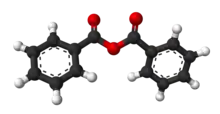 | |
 | |
| Names | |
|---|---|
| Preferred IUPAC name
Benzoic anhydride | |
| Other names
Benzoic acid anhydride Benzoyl anhydride Benzoyl benzoate | |
| Identifiers | |
3D model (JSmol) |
|
| 516726 | |
| ChemSpider | |
| ECHA InfoCard | 100.002.084 |
| EC Number |
|
PubChem CID |
|
| UNII | |
CompTox Dashboard (EPA) |
|
| |
| |
| Properties | |
| C 14H 10O 3 | |
| Molar mass | 226.23 g mol−1 |
| Appearance | White to off-white solid |
| Density | 1.1989 g cm−3 at 15 °C |
| Melting point | 42 °C (108 °F; 315 K) |
| Boiling point | 360 °C (680 °F; 633 K) |
| -124.9·10−6 cm3/mol | |
| Hazards | |
| NFPA 704 (fire diamond) | |
| Flash point | 113[2] °C (235 °F; 386 K) |
| Related compounds | |
Related compounds |
Benzoic acid |
Except where otherwise noted, data are given for materials in their standard state (at 25 °C [77 °F], 100 kPa).
Infobox references | |
Benzoic anhydride is the organic compound with the formula (C6H5CO)2O. It is the acid anhydride of benzoic acid and the simplest symmetrical aromatic acid anhydride. It is a white solid.
Preparation and reactions
It is usually prepared by the dehydration reaction of benzoic acid, e.g. using acetic anhydride:[3]
- 2 C6H5CO2H + (CH3CO)2O → (C6H5CO)2O + 2 CH3CO2H
Alternatively, sodium benzoate can be treated with benzoyl chloride. It can be produced by dehydrating benzoic acid by heating.
Benzoic anhydride provides a convenient way to prepare benzoic esters:
- (C6H5CO)2O + ROH → C6H5CO2H + C6H5CO2R
References
- ↑ "Sciencelab msds". Archived from the original on 2016-03-04. Retrieved 2015-12-26.
- ↑ "aldrich product page".
- ↑ H. T. Clarke; E. J. Rahrs (1923). "Benzoic Anhydride". Org. Synth. 3: 21. doi:10.15227/orgsyn.003.0021.
This article is issued from Wikipedia. The text is licensed under Creative Commons - Attribution - Sharealike. Additional terms may apply for the media files.
